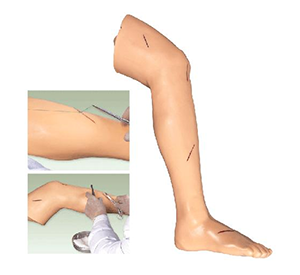Homepageпјҡ NEWS >> Why is the surgical leg suture training model of increasing importance in medical education?
In medical education, surgical training is the key link for every surgeon to improve his skills. Especially for the basic operation of surgery - suture, how to ensure the safety of patients under the premise of efficient and accurate completion, related to the treatment of each patient. In recent years, the importance of surgical leg suture training model in medical education has gradually increased, and how this model helps surgeons improve their skills has become an indispensable part of modern medical training.
why is surgical leg suture training model so important?

Surgical leg suture training model
1. Safety guarantee
Suturing is a basic but critical skill for surgical students. In the early days, students tend to gain experience by watching doctors or by doing a few actual stitches, but this approach carries some risks. The emergence of the surgical leg suture training model allows students to practice repeatedly in a simulated environment, avoiding mistakes that may occur in real surgery and reducing the risk to patients.
2. Simulates a real surgical environment
Modern training models are often highly simulated, simulating real trauma situations and even simulating the feel of skin, fat layers and muscle structure, so that students can learn and operate in an environment as close to reality as possible. This not only enhances their hands-on experience, but also enhances their resilience when dealing with complex situations.
3. Improve operation skills and confidence
Surgical precision requires a high level of hand-eye coordination. Through the suture training model, students can gradually improve their mastery of suture skills through repeated exercises. Continuous practice can effectively shorten the learning curve, so that students have a certain skill base and confidence before entering the operating room, thus reducing the unease and mistakes in clinical practice.
The views of industry experts
In the opinion of experts in the medical field, the surgical leg suture training model provides a new "practical classroom" for medical education. Experts generally agree that surgical training in the past often relied on real patients and limited surgical opportunities, but this approach not only affected the progress of students, but also may bring unnecessary risks to patients. With the development of simulation techniques, training models have become an important tool for "risk-free learning".
A chief surgeon noted that the surgical leg suturing training model not only helps students master basic operations, but also provides practical experience in the face of complex trauma and difficult sutures. This model has been widely used in many fields such as severe trauma treatment and skin repair, and has been highly valued by medical educators and doctors.
Data support
Many studies have shown that the simulation training model can significantly improve the operational skills and clinical performance of surgical students. In a study of surgical suturing skills training, participants experienced a more than 30 percent improvement in their success in actual practice after several simulations using the training model. This suggests that simulation training not only helps students master techniques more quickly, but also improves their performance in actual surgery.
In addition, there are data showing that the failure rate of surgical procedures is reduced in hospitals and medical centers that use training models, especially in the practice of young doctors and beginners, and model training can effectively reduce the error caused by inexperience.
Future development of surgical leg suture training model
As technology continues to advance, surgical training models are constantly being upgraded. Technological innovations have made the experience of training models more realistic and can help doctors better grasp every detail. In the future, these models will not only be limited to leg sutures, but may also be extended to other complex surgical procedures, such as organ repair, minimally invasive surgery and other fields.
In general, the surgical leg suturing training model is becoming increasingly important in medical education, not only because it provides a safe and realistic operating platform for medical students, but also because it greatly improves the skill level and clinical success rate of doctors. With the continuous development of simulation technology, surgical education in the future will pay more attention to the development of skills, and suture training models will undoubtedly continue to play an important role in this process.